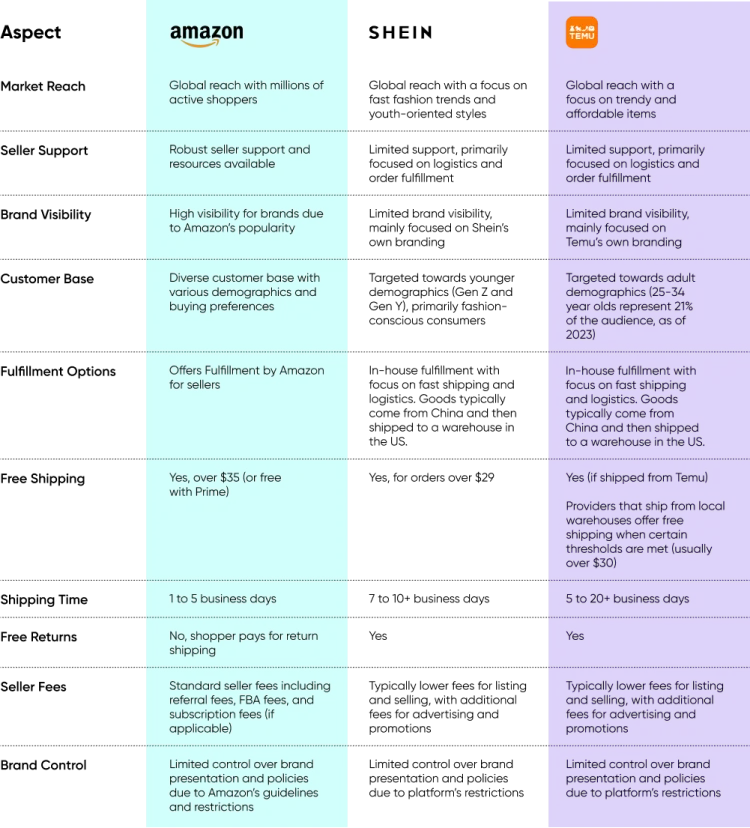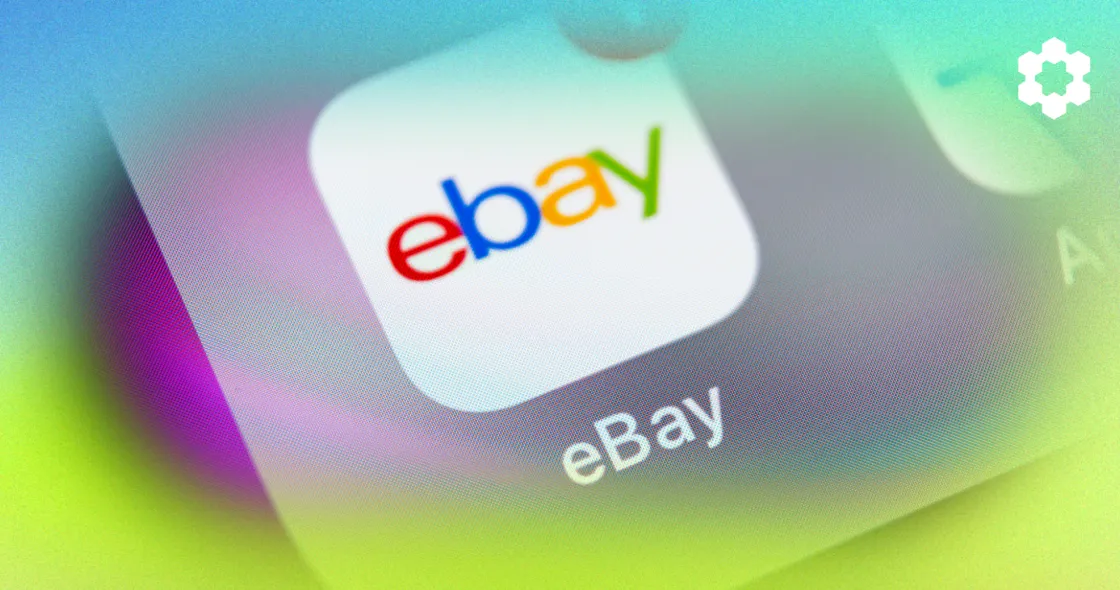Amazon may be the reigning champion of ecommerce, but recent years have shown a growing number of sellers exploring multichannel selling.
A 2022 report by online ecomm resource and community hub, eCommerceFuel, found a slight decline in the number of sellers actively selling on Amazon, dropping from 55.8% to 53%. The study also suggests that although current sellers are not yet intending to leave the platform entirely, off-Amazon brands are exhibiting stronger performance across various metrics compared to their Amazon-based counterparts.
This emerging trend could signify a gradual erosion of the retailer’s dominance in the marketplace over time.
The primary driver behind this trend is the escalating cost of selling on Amazon, coupled with sellers’ frustration over the challenging task of brand-building amid intensifying competition on the platform. For this reason, sellers are recognizing the potential for greater long-term profitability by diversifying their sales channels beyond Amazon.com alone.
Enter Shein and Temu – bargain retailers that have recently been enjoying popularity among US shoppers, startling Amazon. Both companies are actively expanding their US logistics infrastructure, with plans to establish a stronger presence in the market. Some are even making strategic moves to establish a physical presence in locations traditionally dominated by Amazon. Currently, Temu and Shein both have shares of about 1% of the US market, while Amazon has 38%.
In this post, we’ll deep dive into multichannel selling and why some sellers find that now’s the best time to explore alternative platforms beyond Amazon. We’ll also delve into the growing influence of Shein and Temu, highlighting the reasons why you should consider expanding your presence on these platforms to capitalize on emerging trends and capture untapped market potential.
What is Multichannel Selling?
Multichannel selling refers to the practice of selling products across multiple online platforms or marketplaces simultaneously. Rather than relying solely on one platform, such as Amazon or eBay, multichannel sellers expand their reach by listing their products on various channels like their own website, social media platforms, online marketplaces, and other third-party sites. This approach allows sellers to diversify their sales channels, reach a broader audience, and potentially increase sales opportunities.
Additionally, multichannel selling enables sellers to adapt to changing consumer preferences and behaviors, ultimately enhancing their overall diversification strategy and maximizing revenue potential.
Why Multichannel Selling May Be Good For You?

As a seller, there are several compelling reasons to diversify off Amazon.com:
Reduced Reliance on a Single Platform
Putting all your eggs in Amazon exposes you to risks associated with changes in the company’s policies, fees, and algorithms.
For instance, Amazon hiking its FBA fees poses several challenges for sellers, such as thinner profit margins, limited ability to invest in business growth initiatives, competitive disadvantage, and price increases to offset the impact of higher fees.
Data Dive & Seller Systems CEO and Amazon expert, Brandon Young, said it best:
“Amazon doesn’t realize that by squeezing us from multiple angles they are forcing us to raise our prices. When we can’t rank with higher prices we will stop selling on their platform and the only thing left will be cheap unbranded sh-t. Essentially Amazon is moving towards becoming Wish, and we saw how that turned out.”
Therefore, diversifying to other platforms mitigates this risk by spreading sales across multiple channels.
Access to Different Audiences
Different platforms attract distinct audiences with unique preferences and behaviors. Diversifying allows you to tap into new customer segments that may not be active on Amazon, expanding your customer base.
Increased Brand Visibility
Selling on multiple platforms increases brand visibility beyond Amazon, enhancing brand recognition and trust among consumers.
Mitigation of Competition
Amazon’s marketplace is highly competitive, with millions of sellers vying for visibility. Branching out to less saturated platforms can reduce competition and improve the chances of standing out.
Flexibility in Pricing and Promotions
On Amazon, sellers have limited control over pricing and promotions due to Amazon’s pricing policies. Diversifying allows you to implement pricing strategies and promotional campaigns tailored to each platform’s requirements.
If you continue to sell on Amazon, make sure your pricing on other platforms doesn’t violate Amazon’s TOS. For example, a product listed for a lower price on another platform risks being suspended on Amazon.
Protection Against Policy Changes
Amazon frequently updates its policies and algorithms, which can impact sellers’ businesses overnight. Diversifying ensures that sellers are not overly dependent on Amazon’s ecosystem and can adapt to changes more effectively.
Improved Profit Margins
Selling on alternative platforms may offer lower fees and expenses compared to Amazon, resulting in improved profit margins for your business.
Market Expansion
Selling on international or niche-specific platforms enables you to expand your market reach beyond Amazon’s domestic marketplace, tapping into new geographic regions or niche markets.
Signs You May Not Be Ready for Multichannel Selling
Assessing the signs below and addressing any gaps or challenges can help determine if you are prepared to diversify off Amazon completely. It’s essential to approach diversification strategically and ensure that it aligns with your overall business objectives and capabilities.
Limited Brand Awareness
If your brand is relatively unknown or has low visibility outside of Amazon, it may be challenging to attract customers on other platforms.
Dependency on Amazon Sales
If the majority of your revenue comes from Amazon sales and you lack other significant revenue streams, diversifying off Amazon may pose a risk to your overall revenue stability.
Insufficient Resources
Diversifying requires additional resources such as time, money, and manpower to manage multiple sales channels effectively. If you lack the resources to support expansion efforts, it may not be the right time to diversify.
Inadequate Product Catalog
If your product catalog is limited or lacks diversity, expanding to other platforms may not be feasible. Having a broad range of products increases your appeal to customers across different platforms.
Lack of Understanding of Alternative Platforms
If you are unfamiliar with alternative ecommerce platforms, their audience demographics, or their selling requirements, it may be premature to diversify. Proper research and understanding of these platforms are crucial for successful expansion.
Inefficient Operations
If your current operations are not optimized on Amazon, expanding to additional platforms may further complicate your business operations. It’s essential to have efficient processes in place before diversifying.
Carbon6 offers a suite of ecommerce tools designed to enhance profitability and streamline operations. Explore our solutions here.
Unclear Business Goals
If you have not clearly defined your business goals or identified the reasons for diversifying, it may be premature to make the leap. Understanding your objectives and aligning them with your diversification strategy is critical for success.
Lack of Market Demand
If there is limited demand for your products outside of Amazon or if your target market is not active on other platforms, diversifying may not yield significant results.
Inability to Meet Platform Requirements
Each ecommerce platform has its own set of requirements, such as product listing standards, fulfillment options, and seller fees. If you cannot meet these requirements or adapt your business model accordingly, diversification may be challenging.
Fear of Losing Amazon Sales
If you are hesitant to risk losing sales on Amazon or fear negative impacts on your Amazon ranking, it may indicate that you are not ready to diversify completely.
Diversifying Your Sales Across Shein and Temu
Ready to take the leap and explore untapped potential that bargain retailers such as Shein and Temu have to offer?
This comparison chart outlines the key differences between selling on Amazon, Shein, and Temu across various aspects such as market reach, seller support, brand visibility, customer base, fulfillment and shipping options, seller fees, and brand control. It provides you with valuable insights to make informed decisions about which multichannel selling platform(s) align best with your business goals and target audience.

When comparing Amazon, Shein, and Temu, it’s clear they each have their own strengths and quirks. Amazon is the big player with a massive global reach and tons of support for sellers, but you might have to work harder to stand out among the crowd. Not to mention, deal with thinning profit margins as fees go up, making Amazon not the best platform for new sellers.
Shein, on the other hand, is all about those trendy styles, especially for the younger crowd, and they’ve got lower seller fees to sweeten the deal.
For instance, when scrolling through social media, you’ll often stumble upon rave reviews about Shein, praising its bang-for-your-buck deals, trendy offerings, and youthful vibe. Take a peek at TikTok, and you’ll find the #SheinHaul hashtag boasts a whopping 13.3 billion views, showing just how much shoppers love sharing their Shein finds.
According to a survey called “Taking Stock With Teens” by Piper Sandler, 8% of Gen Z picked Shein as their go-to, beating out big names like Nike and Lululemon. And it’s no wonder why Shein’s a crowd favorite – with tees priced at $9, dresses at $14, and jeans at $24, it’s a haven for budget-savvy shoppers.
Plus, when it comes to keeping up with the latest trends, Shein’s the reigning champ on a global scale. Thanks to their savvy use of big data and a flexible supply chain, the fast-fashion retailer churns out over 10,000 new products each day, leaving competitors like H&M and ZARA in the dust with their slower update rates.
As for Temu, it’s like Shein’s slightly older sibling, offering similar features and benefits but aiming for a bit of a different audience.
When it comes to product offerings, for example, Temu stands out for its diverse selection, serving up a meticulously curated range of items at wholesale-like prices sourced from sellers and brands worldwide. In contrast to Shein’s primary focus on fashion, Temu expands its offerings to encompass a broad spectrum of everyday goods spanning over 200 categories, including apparel, footwear, toys, pet supplies, jewelry, and more.
Temu acts as a comprehensive online megastore, presenting a wider array of products compared to Shein’s fashion-centric approach. While both platforms offer affordable clothing, Temu’s strength lies in its ability to cater to diverse needs, allowing customers to discover virtually any product they can think of, just like on Amazon. On the other hand, Shein excels as a go-to destination for fast fashion, particularly renowned for its apparel selections.
Now, in terms of shipping, Amazon leads the race with lightning-fast delivery. Shein and Temu might take a bit longer due to international shipping. Shein and Temu offer free returns, though Amazon makes customers foot the bill for return shipping. In addition, the fees for selling vary, but generally, Shein and Temu tend to be a bit cheaper for sellers.
Lastly, watch out for brand control – all these multichannel selling platforms have their own rules, so you’ve got to adhere to them to keep everything running smoothly.
It’s not uncommon for some sellers to leave Amazon or any other platform for that matter because they feel overwhelmed or confused by the selling process. Understandably, diving into ecommerce can be pretty daunting. However, with the right guidance and a willingness to learn, it can definitely pay off in the long run.
One Big Caveat

Shein and Temu’s emphasis on affordability poses a challenge for sellers, pushing them to adjust their pricing strategies to remain competitive. For instance, for an item that costs a seller $15 to make, Temu may offer to pay $12. Therefore, sellers must weigh the option of reducing their profit margins to attract more sales or risk being sidelined in the marketplace.
In addition, the sustainability of Temu’s remarkably low prices remains uncertain, as the company appears to be heavily subsidizing shipping costs and investing aggressively in marketing to attract customers.
According to Chinese tech publication 36Kr, sources familiar with the matter estimate that Temu is losing $40 for every $100 in sales. During an earnings call in August, Liu Jun, VP of Finance for Temu’s parent company PDD Holdings, indicated that the company is still in a “learning phase” and not yet prioritizing monetization.
Former Alibaba exec Gai noted Temu’s strategy of leveraging small, inexpensive items to rapidly expand its customer base, suggesting that the company may eventually scale back its free shipping policy. Despite these concerns, this approach continues to drive impressive growth, particularly as the US prepares for Q2, with platforms intensifying efforts to attract both customers and sellers with enticing discounts.
For example, back in Q4 2023, Temu promoted a holiday sales event offering discounts of up to 90%, while Shein has introduced its own version of China’s Singles Day with the “11.11 shopping festival.”
Amazon’s Potential Countermove
Amazon, being the powerhouse of ecommerce, possesses the agility and resources necessary to evolve and adapt in response to market dynamics. Here are a few potential ways Amazon might respond:
- Strengthening Unique Selling Point(s): Amazon may opt to bolster its Prime membership program, providing exclusive perks such as special deals and swifter shipping to justify the subscription cost. Additionally, they might allocate resources towards enhancing their own private label brands, renowned for their competitive pricing.
- Prioritizing Personalization Tools: Leveraging its extensive data and logistics infrastructure, Amazon could offer (improved) tailored recommendations and seamless shopping experiences to customers. Moreover, they might focus on curated selections of premium products, appealing to consumers seeking value beyond mere affordability.
- Match Temu’s Prices: Although unlikely to engage in outright imitation, Amazon could draw inspiration from Temu and Shein’s low-pricing tactics and social media-centric approach. Introducing initiatives like more sales events (e.g. Big Spring Sale), collaborations with influencers, and gamified shopping experiences could resonate with budget-conscious shoppers while preserving Amazon’s distinctive brand identity.
Charting the Future: Navigating Challenges and Seizing Opportunities
While Temu and Shein have carved out their place in the US market, their journey forward is riddled with hurdles. Temu’s innovative approach with budget-friendly product offerings has sparked interest, but the company’s longer delivery times and niche product range might hinder wider market penetration, especially among everyday shoppers. Moreover, geopolitical tensions and concerns over data privacy continue to loom as significant obstacles.
On the flip side, Shein’s swift rise in the American market, particularly among the youth with its fast-fashion focus, showcases successful targeting of a key demographic. However, as Shein aims for broader market reach, it must grapple with the complexities of expansion in a fiercely competitive and scrutinized landscape.
Zooming out, the emergence of Shein and Temu reflects a larger trend of retail globalization, blurring geographical boundaries and reshaping consumer behavior. Price sensitivity and the pursuit of novelty are becoming increasingly influential in purchasing decisions.
For Amazon, the challenge is multifaceted: maintaining its stronghold against agile competitors like Temu and Shein while adapting to an evolving retail landscape. Amazon’s ability to innovate across logistics, product offerings, and customer experience will be pivotal as it navigates this transformative era.
Alternatively, if you’re keen on moving towards multichannel selling, equipping your business with the right tools, knowledge, and resources to assist is a pivotal element contributing to ecommerce success. Utilizing an all-in-one ecommerce platform is indispensable.
Carbon6 offers a comprehensive suite of tools catering to Amazon sellers, agencies and aggregators, covering essential aspects such as inventory management, product research, keyword analysis, wholesale sourcing, Amazon PPC, off-Amazon ads, AI-driven listing creation, data management, reimbursement, and more.
With Carbon6, you’ll have everything necessary to navigate the complexities of multichannel selling and propel your business forward.








